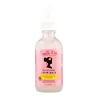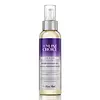What's inside
What's inside
 Key Ingredients
Key Ingredients

 Benefits
Benefits

 Concerns
Concerns

 Ingredients Side-by-side
Ingredients Side-by-side

Water
Skin ConditioningAlcohol Denat.
AntimicrobialSd Alcohol 40-B
AstringentButylene Glycol
HumectantPPG-26-Buteth-26
Skin ConditioningPEG-40 Hydrogenated Castor Oil
EmulsifyingApigenin
AntioxidantOleanolic Acid
Skin ConditioningBiotinoyl Tripeptide-1
Hydrolyzed Vegetable Protein
Skin ConditioningHydrolyzed Vegetable Protein Pg-Propyl Silanetriol
Skin ConditioningXanthan Gum
EmulsifyingSerenoa Serrulata Fruit Extract
Skin ConditioningLavandula Angustifolia Oil
MaskingMentha Piperita Oil
MaskingCitric Acid
BufferingPhenoxyethanol
PreservativeEthylhexylglycerin
Skin ConditioningParfum
MaskingWater, Alcohol Denat., Sd Alcohol 40-B, Butylene Glycol, PPG-26-Buteth-26, PEG-40 Hydrogenated Castor Oil, Apigenin, Oleanolic Acid, Biotinoyl Tripeptide-1, Hydrolyzed Vegetable Protein, Hydrolyzed Vegetable Protein Pg-Propyl Silanetriol, Xanthan Gum, Serenoa Serrulata Fruit Extract, Lavandula Angustifolia Oil, Mentha Piperita Oil, Citric Acid, Phenoxyethanol, Ethylhexylglycerin, Parfum
Glycine Soja Oil
EmollientRicinus Communis Seed Oil
MaskingPrunus Amygdalus Dulcis Oil
Skin ConditioningParfum
MaskingOryza Sativa Bran Extract
Skin ConditioningOryza Sativa Bran Oil
EmollientRosmarinus Officinalis Leaf Extract
AntimicrobialHelianthus Annuus Extract
EmollientHelianthus Annuus Seed Oil
EmollientAloe Barbadensis Leaf Juice
Skin ConditioningApium Graveolens Seed Extract
AntioxidantChamomilla Recutita Flower Extract
MaskingSalvia Officinalis Leaf Extract
CleansingCocos Nucifera Oil
MaskingOenothera Biennis Oil
EmollientVitis Vinifera Seed Oil
EmollientSimmondsia Chinensis Seed Oil
EmollientMelaleuca Alternifolia Leaf Oil
AntioxidantUrtica Dioica Leaf Extract
Skin ConditioningLinum Usitatissimum Seed Extract
PerfumingSalvia Hispanica Seed Extract
EmollientBiotin
AntiseborrhoeicArginine
MaskingPanthenol
Skin ConditioningTocopherol
AntioxidantTocopheryl Acetate
AntioxidantAscorbic Acid
AntioxidantGlycerin
HumectantCaprylic/Capric Triglyceride
MaskingWater
Skin ConditioningItaconic Acid
AntimicrobialPolyglyceryl-10 Laurate
Skin ConditioningMenthyl Ethylamido Oxalate
Skin ConditioningSilica
AbrasiveCitric Acid
BufferingPhenoxyethanol
PreservativePotassium Sorbate
PreservativeSodium Benzoate
MaskingAmyl Cinnamal
PerfumingBenzyl Benzoate
AntimicrobialHexyl Cinnamal
PerfumingLinalool
PerfumingGlycine Soja Oil, Ricinus Communis Seed Oil, Prunus Amygdalus Dulcis Oil, Parfum, Oryza Sativa Bran Extract, Oryza Sativa Bran Oil, Rosmarinus Officinalis Leaf Extract, Helianthus Annuus Extract, Helianthus Annuus Seed Oil, Aloe Barbadensis Leaf Juice, Apium Graveolens Seed Extract, Chamomilla Recutita Flower Extract, Salvia Officinalis Leaf Extract, Cocos Nucifera Oil, Oenothera Biennis Oil, Vitis Vinifera Seed Oil, Simmondsia Chinensis Seed Oil, Melaleuca Alternifolia Leaf Oil, Urtica Dioica Leaf Extract, Linum Usitatissimum Seed Extract, Salvia Hispanica Seed Extract, Biotin, Arginine, Panthenol, Tocopherol, Tocopheryl Acetate, Ascorbic Acid, Glycerin, Caprylic/Capric Triglyceride, Water, Itaconic Acid, Polyglyceryl-10 Laurate, Menthyl Ethylamido Oxalate, Silica, Citric Acid, Phenoxyethanol, Potassium Sorbate, Sodium Benzoate, Amyl Cinnamal, Benzyl Benzoate, Hexyl Cinnamal, Linalool
Alternatives
Ingredients Explained
These ingredients are found in both products.
Ingredients higher up in an ingredient list are typically present in a larger amount.
Citric Acid is an alpha hydroxy acid (AHA) naturally found in citrus fruits like oranges, lemons, and limes.
Like other AHAs, citric acid can exfoliate skin by breaking down the bonds that hold dead skin cells together. This helps reveal smoother and brighter skin underneath.
However, this exfoliating effect only happens at high concentrations (20%) which can be hard to find in cosmetic products.
Due to this, citric acid is usually included in small amounts as a pH adjuster. This helps keep products slightly more acidic and compatible with skin's natural pH.
In skincare formulas, citric acid can:
While it can provide some skin benefits, research shows lactic acid and glycolic acid are generally more effective and less irritating exfoliants.
Most citric acid used in skincare today is made by fermenting sugars (usually from molasses). This synthetic version is identical to the natural citrus form but easier to stabilize and use in formulations.
Read more about some other popular AHA's here:
Learn more about Citric AcidParfum is a catch-all term for an ingredient or more that is used to give a scent to products.
Also called "fragrance", this ingredient can be a blend of hundreds of chemicals or plant oils. This means every product with "fragrance" or "parfum" in the ingredients list is a different mixture.
For instance, Habanolide is a proprietary trade name for a specific aroma chemical. When used as a fragrance ingredient in cosmetics, most aroma chemicals fall under the broad labeling category of “FRAGRANCE” or “PARFUM” according to EU and US regulations.
The term 'parfum' or 'fragrance' is not regulated in many countries. In many cases, it is up to the brand to define this term.
For instance, many brands choose to label themselves as "fragrance-free" because they are not using synthetic fragrances. However, their products may still contain ingredients such as essential oils that are considered a fragrance by INCI standards.
One example is Calendula flower extract. Calendula is an essential oil that still imparts a scent or 'fragrance'.
Depending on the blend, the ingredients in the mixture can cause allergies and sensitivities on the skin. Some ingredients that are known EU allergens include linalool and citronellol.
Parfum can also be used to mask or cover an unpleasant scent.
The bottom line is: not all fragrances/parfum/ingredients are created equally. If you are worried about fragrances, we recommend taking a closer look at an ingredient. And of course, we always recommend speaking with a professional.
Learn more about ParfumPhenoxyethanol is a preservative that has germicide, antimicrobial, and aromatic properties. Studies show that phenoxyethanol can prevent microbial growth. By itself, it has a scent that is similar to that of a rose.
It's often used in formulations along with Caprylyl Glycol to preserve the shelf life of products.
Water. It's the most common cosmetic ingredient of all. You'll usually see it at the top of ingredient lists, meaning that it makes up the largest part of the product.
So why is it so popular? Water most often acts as a solvent - this means that it helps dissolve other ingredients into the formulation.
You'll also recognize water as that liquid we all need to stay alive. If you see this, drink a glass of water. Stay hydrated!
Learn more about Water